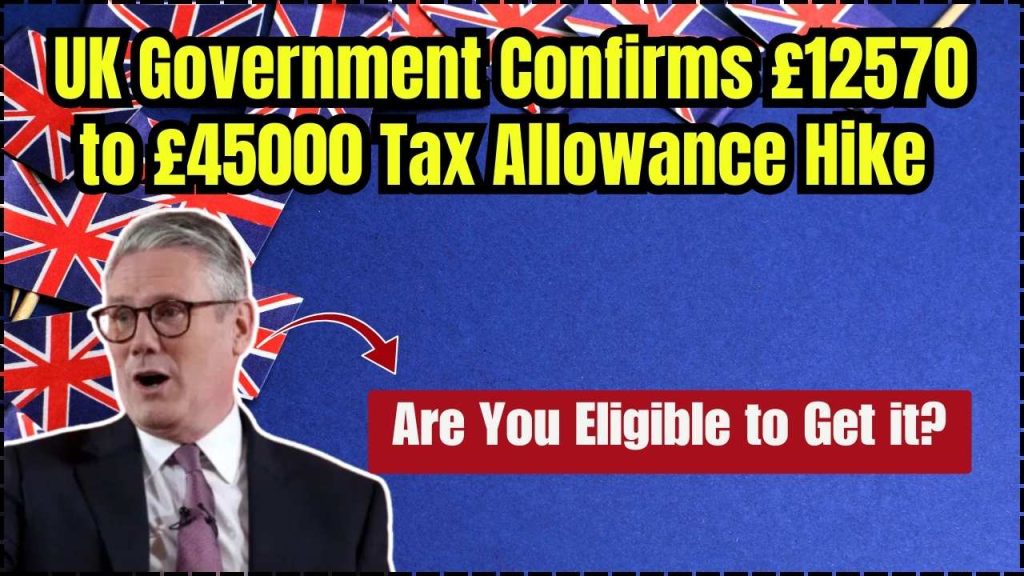UK Government Confirms £12570 to £45000 Tax Allowance: The phrase “UK Government Confirms £12,570 to £45,000 Tax Allowance Hike” has gone viral, raising hopes of major tax savings across the UK. But is it true? Is there really a confirmed policy to raise the Personal Allowance that high? And if so, who qualifies?

In this in-depth guide, we’ll break down what’s fact and what’s fiction, explain how tax allowances work in 2025, and offer clear examples, official links, and practical advice—so you can confidently manage your income, tax, and savings.
UK Government Confirms £12570 to £45000 Tax Allowance
| Topic | Details |
|---|---|
| Current Personal Allowance | £12,570 – the amount of income you can earn tax-free |
| Claimed Hike to £45,000 | No official confirmation; tied to public petition and online speculation |
| Government Position | Treasury confirmed no hike; allowance frozen until April 2028 |
| Tax Bands | Basic: 20% (up to £50,270); Higher: 40%; Additional: 45% |
| Petition Status | Over 35,000 signatures |
| Impact of Hike (if approved) | Could save basic-rate taxpayers over £3,000 a year |
| Official Income Tax Info | GOV.UK Income Tax Rates |
Despite viral headlines, there is no confirmed hike in the Personal Allowance to £45,000. The figure stems from a public petition, not government policy. The current allowance remains at £12,570 and will stay frozen until 2028.
That said, the conversation is important. Millions of workers are struggling with stealth taxes, bracket creep, and high inflation. Being informed, checking your tax status, and claiming every allowance available is the best way to maximize your take-home pay in 2025.
What Is the Personal Allowance?
Your Personal Allowance is the amount of money you can earn each year without paying any income tax. As of April 2025, that figure is £12,570.
After this, your income is taxed in bands:
- Up to £50,270 – taxed at 20%
- £50,271 to £125,140 – taxed at 40%
- Above £125,140 – taxed at 45%
The Personal Allowance has been frozen since 2021, meaning it hasn’t risen with inflation—something that’s quietly dragged more people into higher tax brackets.
Where Did the £45000 Claim Come From?
This figure was widely shared after a public petition on the UK Parliament site called for raising the Personal Allowance from £12,570 to £45,000.
Supporters argue it would:
- Help low- and middle-income workers
- Ease pressure from the cost-of-living crisis
- Increase disposable income
But according to the Treasury’s response:
“Increasing the Personal Allowance to £45,000 would cost the UK government around £39 billion annually, significantly affecting public service funding.”
This proposal is not part of any official 2025 tax policy. It’s a petition, not a law.
Understanding the Impact – Real-Life Example
Let’s break it down with an example.
Meet Sarah:
- Job: Nurse
- Annual Salary: £32,000
Under current rules:
- She pays tax on £19,430 (£32,000 – £12,570)
- Tax = 20% of £19,430 = £3,886
If Personal Allowance was £45,000:
- Her entire income would be tax-free
- She would save nearly £4,000 per year
That’s the kind of impact that caught national attention.
A Quick Look at the History of Tax Allowance
| Tax Year | Personal Allowance |
|---|---|
| 2010 | £6,475 |
| 2015 | £10,600 |
| 2020 | £12,500 |
| 2021–2025 | £12,570 (frozen) |
The allowance rose steadily until 2021. Since then, it’s been frozen to boost tax revenue—a tactic often referred to as a “stealth tax.”
Who Would Benefit Most From a £45,000 Tax Allowance?
Big Winners
- Full-time employees earning up to £45,000
- Freelancers or small business owners under that threshold
- Families living on dual moderate incomes
Not as Beneficial For
- Part-time workers earning under £12,570 (already pay no tax)
- Higher-rate taxpayers (still taxed above £45k)
- Those receiving certain benefits where tax status is irrelevant
What Are the Risks of Raising the Allowance?
While raising the allowance sounds great for workers, there are economic trade-offs:
Pros:
- Boosts disposable income
- Reduces tax burden on middle earners
- Encourages consumer spending
Cons:
- Massive cost to government revenue
- Could lead to cuts in public services
- Higher-income individuals also benefit, which some see as unfair
How to Check Your Tax and Tax Allowance
You can review your tax status easily online:
Step-by-Step:
- Go to: GOV.UK Personal Tax Account
- Sign in with your Government Gateway ID
- View your income, tax paid, and tax code
- Use the Tax Calculator Tool to see how changes affect you
Staying on top of this can help you avoid overpaying tax—or identify missing allowances.
What Can You Do?
Even though a £45,000 Personal Allowance isn’t happening now, here’s what you can do:
- Claim any additional allowances like the Marriage Allowance
- Contribute to pensions to reduce taxable income
- Write to your MP if you support tax reform
- Review your tax code annually
- Share the petition if you believe in the cause
How to Claim the £230 State Pension Boost in 2025 – Check Eligibility Criteria to Get DWP Increase!
New DWP Rules Could Block 1.3M from Sickness Benefits – What’s Changing?
£230 DWP State Pension Boost in 2025: How It Will Benefit Pensioners? Check Details!
FAQs About UK Government Confirms £12570 to £45000 Tax Allowance
Is the UK Personal Allowance really increasing to £45,000?
No. It’s a petition, not a policy. The government has not approved this change.
When will the Personal Allowance increase next?
Not until April 2028, and only in line with inflation.
How can I pay less tax now?
Consider:
- Marriage Allowance
- Blind Person’s Allowance
- Pension contributions
- ISA savings
Why do I pay more tax even with the same salary?
Because of frozen thresholds, your income may enter a higher tax bracket even if your pay increase is small.











